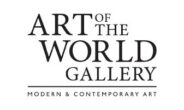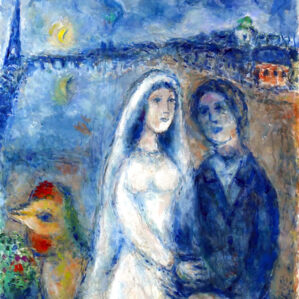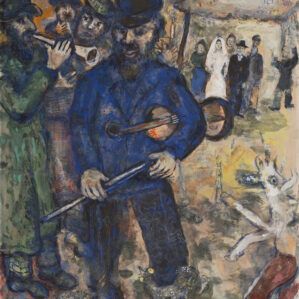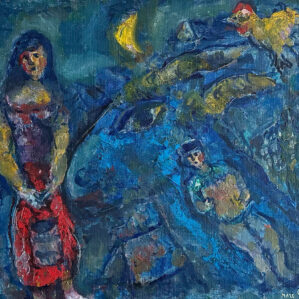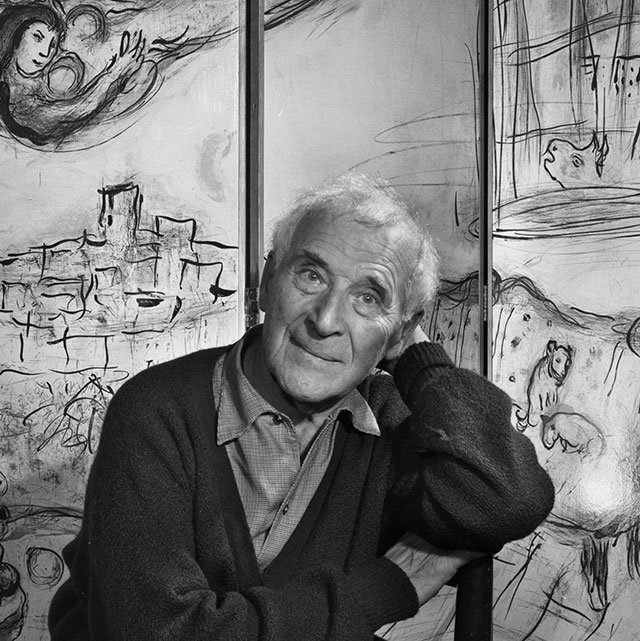
Marc Chagall
“The dignity of the artist lies in his duty of keeping awake the sense of wonder in the world.”
Belarusian-French Marc Chagall (1887-1985) is known for creating works based on emotion and his life experience. Born in a small town in Belarus, he attended the Jewish elementary school, where he began learning the fundamentals of drawing. At 19, he enrolled at an all-Jewish art school and formally began his art education, later transferring to the Imperial Society for the Protection of Fine Arts in St. Petersburg. (Read More)
Explore artwork
Chagall established his own style which is characterized by the dreamlike visions, people, and places that were symbolic to him. By 1910, he moved to Paris where he encountered artists Robert Delaunay, Juan Gris, and the movements of Fauvism and Cubism. During his time in Paris, he created some of the most important artworks of his entire career.
In the 1960s Chagall avidly traveled around the world, often in association with large-scale commissions he received. Among these were windows for the synagogue of the Hadassah University Medical Center, Jerusalem, Israel (installed in 1962); a ceiling for the Paris Opéra (installed in 1964), Paris, France; a window for the United Nations building, New York (installed in 1964); murals for the Metropolitan Opera House, New York (installed in 1967); and windows for the cathedral in Metz, France (installed in 1968).
Among his many accomplishments include, being awarded the Grand Medal of the Legion of Honor in 1977, known as France’s highest distinction. That very same year, he was one of only a handful of artists in history to be selected to receive a retrospective exhibition at the Louvre. He passed away on March 28, 1985, in Saint-Paul-de-Vence at age 97, leaving behind an extensive collection of artworks along with a lush legacy as an exemplary Jewish artist and pioneer of modernism.
SELECTED EXHIBITIONS
Important Exhibitions
2022-2023 Chagall, Schirn Kunsthalle, Frankfurt, Germany
2018 Chagall: The Breakthrough Years, 1911-1919, Guggenheim Museum Bilbao, Spain
2015 Chagall, Royal Museum of Fine Arts of Belgium, Brussels, Belgium
2013-2014 Chagall: Love, War, And Exile, The Jewish Museum, New York, USA
2013 Chagall: Modern Master, Tate, Liverpool, England
2013 Chagall: Beyond Color, Dallas Museum of Fine Arts, Dallas, Texas, USA
2012 Marc Chagall: livre d’artiste, State Hermitage Museum, St Petersburg, Russa
1985 Chagall, Royal Academy of Arts, London, England
1967 Le Message Biblique de Marc Chagall, Musée du Louvre, Paris, France
1946 Marc Chagall, MoMA, New York, USA
Important Group Exhibitions
2021 Icons of Modern Art, The Morozov Collection, Fondation Louis Vuitton, Paris, France
2018-2019 Chagall, Lissitzky, Malevich: The Russian Avant-Garde in Vitebsk, The Jewish Museum, New York, USA
2015 Picasso, Matisse, Chagall, Sangre de Cristo Arts Center, Pueblo, Colorado, USA
2015 Defining Modernism, San Diego Museum of Art, San Diego, California, USA
2011-2012 Chagall and the Russian Avant-Garde, The Art Gallery of Ontario, Canada
Biennale
1948 24th Venice Biennale, Italy
